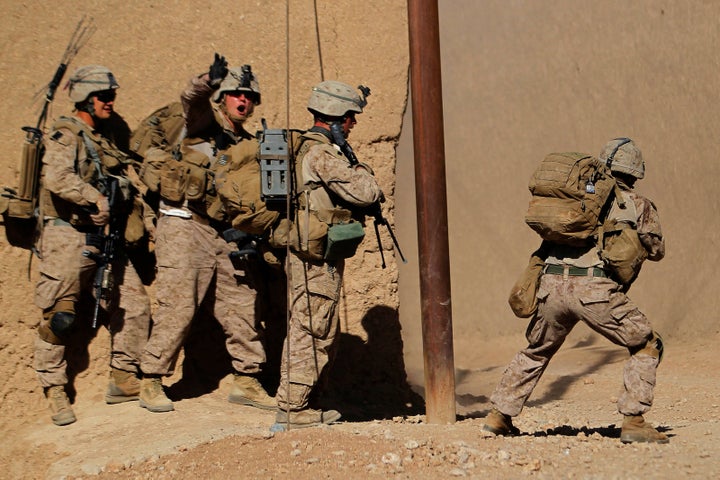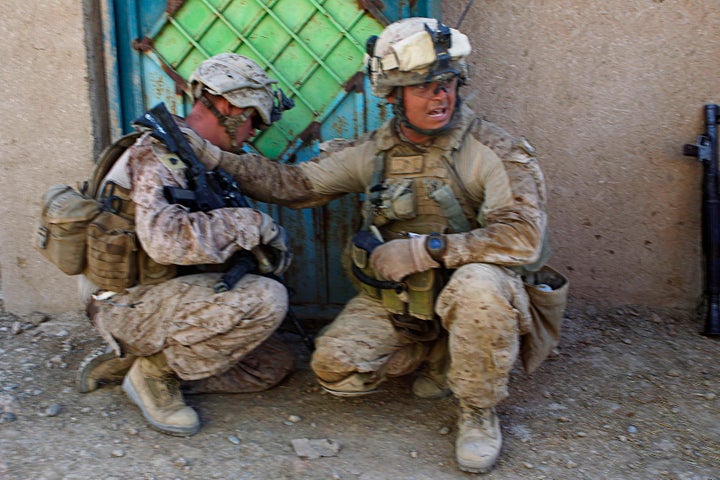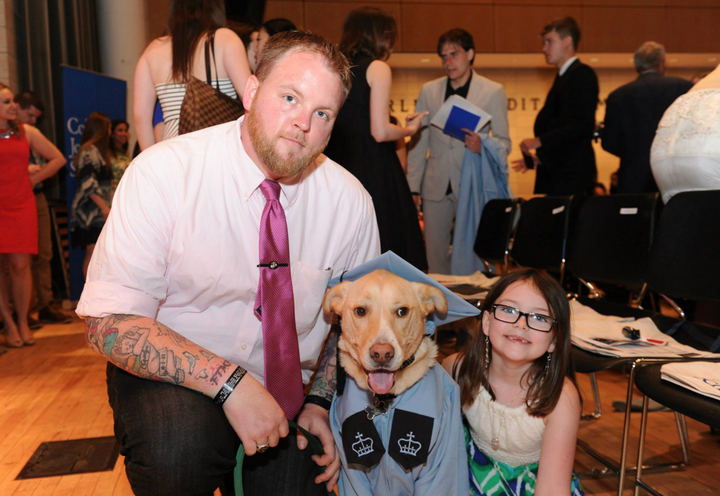
You could say The War Horse -- an ambitious new digital magazine currently raising funds on Kickstarter -- all started with a rocket-propelled grenade.
On Nov. 1, 2010, U.S. Marine Sgt. Thomas Brennan, then 25, was in Helmand province, Afghanistan, when that grenade exploded feet away from him.
He wrote about it later in The New York Times:
Looking up from the ground, it felt surreal. My ears were ringing. The sun was blinding. It felt as if I had been asleep for hours. Looking to my right I saw a silhouette begin to cut through a thinning cloud of smoke. He appeared to be moving in slow motion. Soon, he was standing above me, helping me to my feet. We took turns running back to cover.
Moments earlier, I had been sprinting to an alleyway as my squad of Marines engaged a team of insurgents in Nabu Agha, Afghanistan. A rocket-propelled grenade struck a telephone pole next to me and knocked me unconscious.

Brennan, a Massachusetts native who joined the Marines in 2003, suffered a traumatic brain injury that day -- his third. When he got back to the U.S., he found that his brain injuries, compounded by severe post-traumatic stress disorder from over a year serving as an infantry assaultman in Iraq and Afghanistan, were creating for him a constant struggle with paranoia, insomnia, anxiety and panic attacks.
In late 2012, after more than 18 months of trying to cope with these conditions, Brennan attempted suicide, like so many veterans have. He swallowed a bottle of sleeping pills, but made himself throw them up when, he later wrote, he imagined his daughter "crying at my flag-draped coffin."
“Who the hell are you to say no to The New York Times? Especially when you perceive yourself as some dumb grunt who got blowed up in Afghanistan.””
- Thomas Brennan
His brain injuries had also caused him to develop aphasia, a communicative disorder that Brennan describes as always having the word on the tip of his tongue, but “not being able to get it out.” The military sent him to a therapist.
“He handed me a notebook and was like, 'Just write -- write so we have something to go off of,'” Brennan told The Huffington Post. “And I just started writing.”

One of the first things Brennan wrote was a letter to the war photographer and journalist Finbarr O’Reilly. O’Reilly, who was then with Reuters, had been embedded with Brennan’s platoon, and photographed the moments right after Brennan was injured. Those photos would later appear in The New York Times.
“The pictures he took, the story that he wrote, helped me fill in a lot of the blanks, sparked memories I have now, or things I perceive as memories,” Brennan said. “So I wrote a thank-you letter to him.”
But Brennan says he “didn’t want to send some crappy-ass letter” to an accomplished journalist like O’Reilly without an edit, so he sent a first draft to David Dunlap, an editor at the Times who had worked with O'Reilly before. When Dunlap read Brennan's letter, he asked if he could print it in the paper.
“And who the hell are you to say no to The New York Times?” Brennan remembers thinking. “Especially when you perceive yourself as some dumb grunt who got blowed up in Afghanistan.”
Brennan went on to write more than a dozen pieces for the Times. His work has also appeared in the newspaper Stars and Stripes, and on The Huffington Post.
After Brennan was medically retired from the military, his passion for journalism grew. He worked for two years at a North Carolina newspaper and earned a master’s degree at the Columbia University Graduate School of Journalism. He found the act of writing and reporting “therapeutic,” he said.
Now Brennan is focusing his efforts on The War Horse, an online magazine that bills itself as “the authority” on America’s post-9/11 conflicts and wars, and as the “ONLY digital magazine profiling all men, women, interpreters, and dogs killed since 9/11.”
The War Horse plans to devote significant investigative resources into looking at the Department of Defense, the U.S. armed forces and the scandal-plagued Department of Veterans Affairs. But the main goal of the site, Brennan says, will be to humanize the men and women who serve overseas.
While he acknowledges that there are already some writers and publications doing a good job of covering the military, Brennan says his experience as a soldier and veteran will make The War Horse an invaluable resource.
"I think the one common thread that I bring to the table is I know the fear that exists [among troops] when it comes to approaching journalists," he recently told Military.com. "Having people who are personally involved in these different worlds is going to open up the possibilities."
Some of the first stories on the site, according to Brennan, will include an article about intimacy after genital mutilation from war and a profile of a recent Medal of Honor recipient. The site will also create a database to keep track of suicides among veterans.
One section of The War Horse, called The Echoes Project, seeks to create multimedia profiles for every soldier, interpreter and dog killed in Afghanistan and Iraq -- the two longest-running conflicts in American history.
The idea, Brennan said, came to him after watching journalists scramble to interview the few living veterans of World Wars I and II. His hope is that thanks to The War Horse, “journalists of the future, and average people of the future, [won't] have to scramble to get stories from my generation before we die,” he said in a recent radio interview.

The Echoes Project will include profiles of military dogs, Brennan says, because “those working dogs were out there on every single patrol."
"They come back with blisters, or bleeding... or they overheat on patrol, get shot, get blown up, just like we did," he said. "I think they’re as much of a team as any of the service members or the interpreters who were killed as well. Everyone involved helps accomplish the mission.”
Brennan has a dog of his own, Mr. Luke, that goes everywhere with him and helps him cope with his PTSD. Re-integrating into civilian life, he said, was “very stressful and very scary, especially when you haven’t known it for 10 years.”
“Anybody who tells you they weren’t scared in combat is completely full of crap,” he went on. “My guys made it OK for me to go out there and address how scary and real everything was [in Iraq and Afghanistan], and Mr. Luke did the exact same thing for me here.”
The War Horse boasts an impressive board of advisers. Besides O’Reilly, there is Bruce Shapiro, director of the Dart Center for Journalism and Trauma at Columbia University, whose bio on the site says he will ensure The War Horse's "adherence to ethical journalism practices"; Kevin Cullen, a Pulitzer Prize-winning columnist for The Boston Globe whose "extensive newsroom experience," per the site, "will guide The War Horse in creating thoroughly and responsibly reported works of investigative journalism"; and military veterans and journalists Brigette McCoy and Tahlia Burton, who specialize respectively in coverage of female veterans and coverage of human rights issues.
The War Horse has gotten an assist from the real estate business CRI Properties, which donated an office space in North Carolina, where Brennan lives. The Institute for Non-Profit News has also been a major help, and various donors have contributed furniture, computers, Web hosting and more.
But now Brennan needs an infusion of $50,000 to fund the site’s first series of long-form stories, to start profiling the people and animals killed in action in post-9/11 conflicts, and to assist with grant-writing and further fundraising to help the site grow. With less than 48 hours left on its Kickstarter, as of Monday afternoon The War Horse is still some $16,000 short of its goal.
Brennan says the site will officially launch on Sept. 11, 2016, the 15th anniversary of the terror attacks that sent him to war overseas.
CORRECTION: An earlier version of this article said that the Institute for Non-Profit News played a role in helping Brennan secure an office space. In fact, that space was donated by CRI Properties.
Also on HuffPost:

